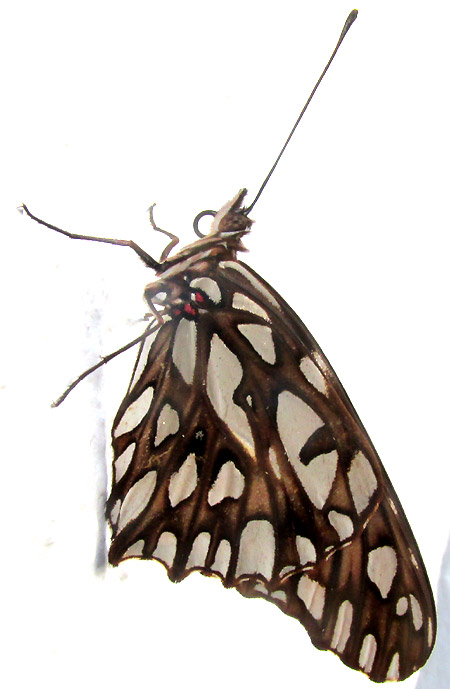Excerpts from Jim Conrad's
Naturalist Newsletter
Entry dated August 5, 2023, issued from near Tequisquiapan, elevation about 1,900m (6200 ft), Querétaro state, MÉXICO
(~N20.57°, ~W99.89°)
MEXICAN SILVERSPOT

A little after dawn while it was still a bit chilly, the above butterfly hung on the white, limewashed wall of a house, on the side facing the backyard. The creature didn't want to fly, as if it were cold or -- as frequently with moths who have spent the night circling the above night-light -- exhausted, or maybe just emerged from its chrysalis. Since only four of its six legs clung to the wall, with the front pair of legs, the forelegs, being much reduced and held up against its "chest," apparently it was a member of the largest of the six or seven butterfly families, the Brush-footed Butterfly Family, the Nymphalidae. However, beyond that, I needed to send the picture to volunteer butterfly identifier Bea in Ontario.
Bea found the identification a challenge, mainly because by just seeing the underwings as shown above, it's hard to imagine that when the butterfly spreads the wings, the topside is brightly brownish-orange, with bold black markings.
It fooled me, too, even though earlier in the year the same backyard had been frequented by a similar species of the same genus. That had been the Juno Silverspot whose black-and-orange caterpillars had fed on the ornamental passionflower vines. Its wing undersides had been very similarly marked and subdued-looking, though the patterns had been subtly different. Bea said our wall-percher was another silverspot, the Mexican Silverspot, DIONE MONETA ssp. POEYII.
The butterfly has an English name because it's distributed from the dry southwestern US southward deep into South America. Three subspecies are recognized, of which our poeyii occurs from the US into northern South America, and the two others are strictly South American.
Our Mexican Silverspot's caterpillars also feed on passionflower vines, while adults take flower nectar from many sources.
I wonder about our butterfly being found below that night-light; could it have been flying at night orienting by stars, and ended up dazed below the light after crashing into it all night? Probably not, if only because its wings showed no signs of battering. Still, I read that the white spots on the wings' undersides are not only white, but also reflective, which might serve a purpose in dim light.
Also, the 1969 study by Lawrence Gilbert entitled "On the Ecology of Natural Dispersal: Dione moneta poeyii in Texas (Nymphalidae)," a good case is made that the species is capable of expanding northward into places where usually it's not found, when winter weather is unusually warm. Gilbert found a Mexican Silverspot in Texas, where it was part of "mixed migratory flight" whose other species were known migrants. Also he writes that the species "... has been known to shift to lower elevations in northern Mexico during the winter dry season." Maybe our individual was making a local flight into the mountains just to our east, but I still wonder about it being below that night-light.